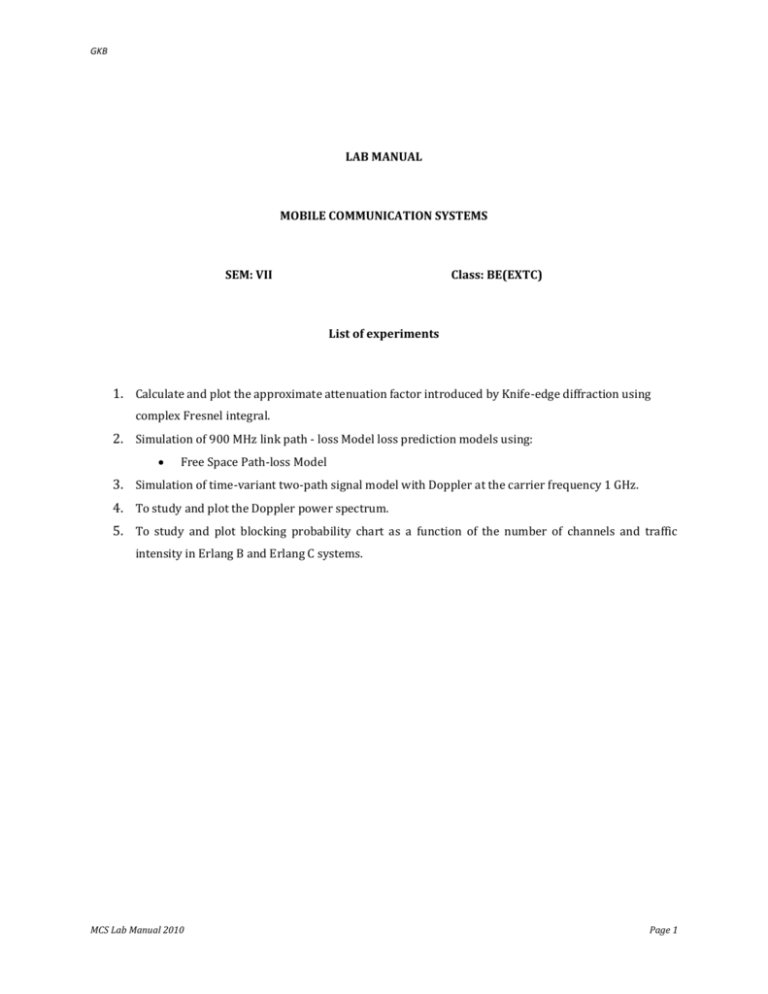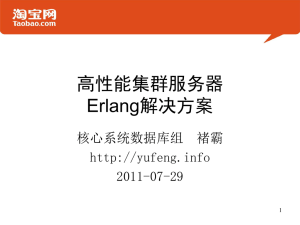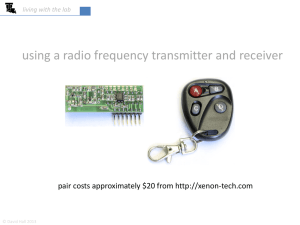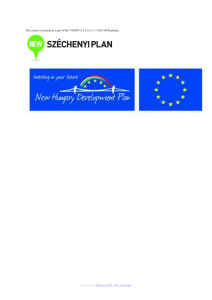GKB LAB MANUAL MOBILE COMMUNICATION SYSTEMS SEM: VII
advertisement

GKB
LAB MANUAL
MOBILE COMMUNICATION SYSTEMS
SEM: VII
Class: BE(EXTC)
List of experiments
1. Calculate and plot the approximate attenuation factor introduced by Knife‐edge diffraction using
complex Fresnel integral.
2. Simulation of 900 MHz link path - loss Model loss prediction models using:
Free Space Path-loss Model
3. Simulation of time-variant two-path signal model with Doppler at the carrier frequency 1 GHz.
4. To study and plot the Doppler power spectrum.
5. To study and plot blocking probability chart as a function of the number of channels and traffic
intensity in Erlang B and Erlang C systems.
MCS Lab Manual 2010
Page 1
GKB
Experiment No.1
Aim: Calculate and plot the approximate attenuation factor introduced by Knife-edge diffraction using
complex Fresnel integral.
Equipment/Software: Scilab 5.5.0
Theory: Estimating the signal attenuation caused by diffraction of radio waves over and buildings is
essential in predicting the field strength in a given service area. Generally, it is impossible to make very
precise estimates of the diffraction losses, and in practice prediction is a process of theoretical approximation
modified by necessary empirical corrections. Though the calculation of diffraction losses over complex and
irregular terrain is a mathematically difficult problem, expressions for diffraction losses for many simple
cases have been derived. The limiting case of propagation over a knife-edge gives good insight into the order
of magnitude of diffraction loss.
When shadowing is caused by a single object such as a hill or mountain, the attenuation caused by
diffraction can be estimated by treating the obstruction as a diffracting knife edge. This is the simplest of
diffraction models, and the diffraction loss in this case can be readily estimated using the classical Fresnel
solution for the field behind a knife edge (also called a half-plane). Figure 1 illustrates this approach.
Figure 1: Illustration of knife-edge diffraction geometry. The receiver R is located in the shadow region.
Consider a receiver at point R, located in the shadowed region (also called the diffraction zone). The field
strength at point R in Figure 1 is a vector sum of the fields due to all of the secondary Huygens’s sources in
the plane above the knife edge. The electric field strength, Ed of a knife-edge diffracted wave is given by,
MCS Lab Manual 2010
Page 2
GKB
𝐸𝑑
(1 + 𝑗) ∞
(−𝑗𝜋𝑡 2 )
= 𝐹(𝑣) =
∫ exp(
)𝑑𝑡 … (1)
𝐸0
2
2
𝑣
where E0 is the free space field strength in the absence of both the ground and the knife edge, and F(v) is the
complex Fresnel integral. The Fresnel integral, F(v), is a function of the Fresnel-Kirchoff diffraction parameter
v, which is given by,
𝑣 = ℎ√
2(𝑑1 + 𝑑2 )
2𝑑1 𝑑2
= 𝛼√
… (2)
𝜆𝑑1 𝑑2
𝜆(𝑑1 + 𝑑2 )
is commonly evaluated using tables or graphs for given values of v. The diffraction gain due to the presence of
a knife edge, as compared to the free space E-field, is given by
𝐺𝑑 (𝑑𝐵) = 20𝑙𝑜𝑔|𝐹(𝑣)|… (3)
Figure 2: Knife-edge diffraction gain as a function of Fresnel diffraction parameter v
In practice, graphical or numerical solutions are relied upon to compute diffraction gain. A graphical
representation of 𝐺𝑑 (𝑑𝐵) as a function of v is given in Figure 2. An approximate solution for equation (3)
provided by Lee as,
𝐺𝑑 (𝑑𝐵) = 0𝑣 ≤ −1
𝐺𝑑 (𝑑𝐵) = 20𝑙𝑜𝑔(0.5 − 0.62𝑣) − 1 ≤ 𝑣 ≤ 0
MCS Lab Manual 2010
Page 3
GKB
𝐺𝑑 (𝑑𝐵) = 20 log(0.5 𝑒𝑥𝑝(−0.95𝑣)) 0 ≤ 𝑣 ≤ 1
𝐺𝑑 (𝑑𝐵) = 20 log (0.4 − √0.1184 − (0.38 − 0.1𝑣)2 ) 1 ≤ 𝑣 ≤ 2.4
𝐺𝑑 (𝑑𝐵) = 20 log (
MCS Lab Manual 2010
0.225
𝑣
) 𝑣 > 2.4
Page 4
GKB
Experiment No.2
Aim: Simulation of 900 MHz link path loss prediction models using:
1.
Free Space Path-loss Model
Equipment/Software: Scilab 5.5.0
Theory: By combining analytical and empirical methods the propagation models are derived. Propagation
models are used for calculation of electromagnetic field strength for the purpose of wireless network
planning during preliminary deployment. It describes the signal attenuation from transmitter to receiver
antenna as a function of distance, carrier frequency, antenna heights and other significant parameters like
terrain profile (e.g. urban, suburban and rural).
Models such as the Harald.T. Friis free space model are used to predict the signal power at the receiver end
when transmitter and receiver have line-of-sight condition. The classical Okumura model is used in urban,
suburban and rural areas for the frequency range 200 MHz to 1920 MHz for initial coverage deployment. A
developed version of Okumura model is Hata-Okumura model known as Hata model which is also extensively
used for the frequency range 150 MHz to 2000 MHz in a build up area. The various propagation models for
path loss can be categorized into three types:
1.
Empirical Models
2.
Deterministic Models
3.
Stochastic Models
Necessity of Propagation Models: It is necessary to estimate a system’s propagation characteristic through
a medium so that the signal parameters can be more accurate in mobile system. Propagation analysis is very
important in evaluating the signal characteristics. For wireless communication system, the system should
have the ability to predict the accurateness of the radio propagation behavior. Thus it has become pivotal for
such system design. The site measurements are expensive and costly. Propagation models have been
developed as low cost, convenient alternative and suitable way. Channel modeling is essential for
characterized the impulse response and to predict the path loss of a propagating channel. Path loss models
are important to design base stations, that can be estimated us to radiate the transmitter for service of the
certain region. Channel characterization deals with the fidelity of the received signal. The main thing of
designing a receiver is to receive the transmitted signal that has been distorted due to the multipath and
dispersion effects of the channel, and that will receive the transmitted signals. It is very important to have the
knowledge about the electromagnetic environment where the system is operated, and the location of the
transmitter and receiver.
1 Free Space Path-loss for Line Of Sight (LOS) Environment:
Free space path loss provides a means to predict the received signal power when there is no object
obstructing the LOS path between the transmitter and the receiver. The model for path loss in a LOS
MCS Lab Manual 2010
Page 5
GKB
environment is straightforward. The received power Pr is related to the transmitted power Pt via the Friis
transmission formula:
𝑃𝑟 =
𝐸𝐼𝑅𝑃
𝑃𝑡 𝐺𝑡 𝐺𝑟 𝜆2
𝐴𝑒 =
(𝑤) … (1)
2
4𝜋𝑑
(4𝜋𝑑)2
Where 𝐸𝐼𝑅𝑃 = 𝑃𝑡 𝐺𝑡. .The transmitting antenna has gain Gt while the receiving antenna has gain Gr . Distance
d is the separation between the transmitter and the receiver. The receiver has an effective aperture given by,
𝐴𝑒 =
𝐺𝑟 𝜆2
… (2)
4𝜋
where λ is the signal wavelength. The path loss is defined by the term,
𝐿=
𝑃𝑟
𝐴𝑒
𝜆 2
=
=(
) … (3)
2
𝑃𝑡 𝐺𝑡 𝐺𝑟 4𝜋𝐺𝑟 𝑑
4𝜋𝑑
It is shown that for the LOS environment, the power received will fall off with the square of the distance
between the transmitter and the receiver.
2. Path-loss for Non LOS Environment:
Since there are scattering objects in the channel, it is quite likely that the transmitted signal cannot reach the
receiver directly since the LOS path is blocked by these objects. These objects can greatly impact the average
signal strength at the receiver. Unlike the LOS case, the modeling of path loss in the NLOS environment is
more complex and involves more environmental parameters in the model. A popular NLOS path-loss model is
semiempirical and assumes the form,
𝑑
𝐿(𝑑) = 𝑃𝐿 (𝑑0 ) + 10𝑛𝑙𝑜𝑔10 ( ) + 𝑆(𝑑)𝑑𝐵 … (4)
𝑑0
PL(d0) is the path loss at a reference distance d0 from the transmitter, S(d) accounts for the lognormal shadow
fading effects, and n is the path-loss exponent.
MCS Lab Manual 2010
Page 6
GKB
Experiment No.3
Aim: Simulation of time-variant two-path signal model with Doppler at the carrier frequency 1 GHz.
Equipment/Software: Scilab 5.5.0
Theory: When the receiver is moving at a speed of v, the Doppler effect leads to a frequency shift of −
𝑣
the receiver is moving away from the transmitter, or
𝜆
𝑣
𝜆
if
if it is moving toward the transmitter. When the
receiver is moving away from the transmitter, we have,
𝑦(𝑡) = 𝑎1 cos (2𝜋 (𝑓𝑐 −
𝑣 𝑐𝑜𝑠∝1
𝜆
) 𝑡 − 𝛽𝑑1 ) + 𝑎2 cos (2𝜋 (𝑓𝑐 −
𝑣 𝑐𝑜𝑠∝2
𝜆
) 𝑡 − 𝛽𝑑2
… (1)
Where 𝛼1 and 𝛼2 are the relative angles of the two paths with the moving direction. Since the speed of
movement is always very small compared to the speed of light, the Doppler shift is very small. The
superposition of two signals at slightly different carriers 𝑓1 and 𝑓2 leads to a beating envelope with a time
interval of |𝑓
1
1 −𝑓2 |
=
𝜆
𝑣|𝑐𝑜𝑠𝛼1 −𝑐𝑜𝑠𝛼2 |
. This can be more clearly seen by,
𝑦(𝑡) = 𝑎1 cos(2𝜋𝑓𝑐 𝑡 − 𝛽(𝑣𝑡𝑐𝑜𝑠 ∝1 + 𝑑1 )) + 𝑎2 cos(2𝜋𝑓𝑐 𝑡 − 𝛽(𝑣𝑡𝑐𝑜𝑠 ∝2 + 𝑑2 ))… (2)
Accordingly, if 𝑣(𝑐𝑜𝑠 ∝1 − 𝑐𝑜𝑠 ∝2 )𝑡 + (𝑑1 − 𝑑2 ) = 𝑚𝜆, we may get peaks. Thus, the spacing between the
peaks and that between the valleys are both
𝜆
𝑣|𝑐𝑜𝑠𝛼1 −𝑐𝑜𝑠𝛼2 |
. Unlike the time-invariant two-path model, the
signal at the receiver will oscillate as it moves past each wavelength.
Here, the two-path model with Doppler is simulated using following parameters:
1.
fc= carrier frequency is 1 GHz
2.
a1=a2=0.45
3.
d1=100m
4.
d2=160m
5.
∝1 =500
6.
∝2 =300
For multiple paths, by assuming that the total power of the multipath components does not change over the
2
region of observation, that is∑𝑁
𝑖=1|𝑎𝑖 | = 𝐶𝑃 where CP is a constant and that the phases are uniformly
distributed in [0,2π]. The Rayleigh distribution can be derived.
MCS Lab Manual 2010
Page 7
GKB
Experiment No.4
Aim: To study and plot the Doppler power spectrum.
Equipment/Software: Scilab 5.5.0
Theory:
Multipath components lead to delay dispersion, while the Doppler effect leads to frequency
dispersion for a multipath propagation. Doppler spread is also known as time-selective spread. Frequencydispersive channels are known as time-selective fading channels. Signals are distorted in both the cases.
Delay dispersion is dominant at high data rates, while frequency dispersion is dominant at low data rates.
These distortions cannot be eliminated by just increasing the transmit power, but can be reduced or
eliminated by equalization or diversity.
For moving MS, different multipath components arrive from different directions, and this gives rise to
different frequency shifts v, leading to a broadening of received spectrum. Assuming a statistical distribution
of a multipath component direction 𝜃, 𝑃𝜃 (𝜃) and the antenna pattern𝐺(𝜃), the Doppler spectrum is derived
as,
̅ [𝑃𝜃 (𝜃)𝐺(𝜃)+𝑃𝜃 (−𝜃)𝐺(−𝜃)]
Ω
𝑆𝐷 (𝑣) = {
𝑣𝜖[−𝑣𝑚𝑎𝑥 , 𝑣𝑚𝑎𝑥 ]
2
√𝑉𝑚𝑎𝑥
−𝑣 2
… (1)
0𝑜𝑡ℎ𝑒𝑟𝑤𝑖𝑠𝑒
̅ is the mean power of the arriving field, and 𝑣𝑚𝑎𝑥 = 𝑓𝑐 𝑣 is the maximum frequency shift due to the
Where Ω
𝑐
Doppler effect, v being the speed of the MS. Note that waves from directions – 𝜃𝑎𝑛𝑑𝜃 have the same Doppler
shift.
According to the Clarke or Jakes model, the angle distribution of scattering is assumed to be uniform from all
azimuthal directions, i.e., 𝑃𝜃 (𝜃) =
1
2𝜋
. For a symmetrical antenna like a dipole this leads to,
𝑆𝐷 (𝑣) =
̅
𝐺(𝜃)Ω
2
𝜋√𝑣𝑚𝑎𝑥
−𝑣 2
… (2)
This spectrum has U-shape, and this is known as classical Doppler or Jakes spectrum. It can be derived via the
Wiener-Khintchin theorem, i.e., the Fourier transform of the autocorrelation of the complex envelope of the
received signal.
̅ = 1, and we Vmax =1 and 10 Hz.
In this simulation we assume that, 𝐺(𝜃)Ω
MCS Lab Manual 2010
Page 8
GKB
Experiment No.5
Aim: To study and plot blocking probability chart as a function of the number of channels and traffic intensity
in Erlang B and Erlang C systems.
Equipment/Software: Scilab 5.5.0
Theory: For a given quality of service (QoS), the capacity of a multiple access network is referred to as the
average number of users that can be serviced. QoS can be defined as 100% minus the percentage of blocked
call, minus ten times the percentage of lost calls. Cellular systems rely on trunking to accommodate a large
number of users in a pool of a limited number of channels. Each user is allocated a channel on a per-call basis.
The trunking theory was developed by Erlang in the late 19 th century. The unit of traffic density is now called
erlang. One erlang represents the traffic intensity of a channel that is completely occupied.
For a large system, the calls from users are random, and satisfy Poison’s distribution. Assuming the total call
arrival is λ calls per second, the probability of call service time t longer than T is given by,
𝑃𝑟 (𝑡 > 𝑇) = 𝑒 −𝜇𝑇 ,𝑇 > 0
Where the average interval for call is 1⁄𝜇 . Define𝑇𝑡𝑟 = 𝜆⁄𝜇, measured in erlang, then 𝑇𝑡𝑟 is the average traffic
offered in the unit of users (channels).
Two models are usually used to characterize the Erlang capacity: lost call clearing (LCC) and lost call hold
(LCH). In the LCC model, if a new user wants to enter a network with all time/frequency slots occupied, it can
only leave and then will re-enter after a random interval as a new user. This causes a slight increase in λ. The
number of total states is thus 1+NC, where NC is the number of available channels. In the LCH model, the user
that is not served will repeat its request for service and stay in the network. This leads to a slight increase in
the average interval for calls 1⁄𝜇 , and the number of states will approach infinity. In both the cases,𝑇𝑡𝑟 = 𝜆⁄𝜇
is slightly increased. Analysis of both the models is based on Markov model.
Erlang B equation:
The LCC models can be used to compute the call blocking probability of a time/frequency slot system by one
BS. The probability of call blocking is given by,
𝑁
𝑃𝑏𝑙𝑜𝑐𝑘 =
𝑇𝑡𝑟𝑐 ⁄𝑁𝑐 !
𝑘⁄
𝑐
∑𝑁
𝐾=0 𝑇𝑡𝑟 𝑘!
This is known as the Erlang B equation. The blocking probability during the busiest hour is defined as the
grade of service (GoS), which must be estimated by the system designer. The GoS for the AMPS system was
designed as 2%.
MCS Lab Manual 2010
Page 9
GKB
Figure 1: Block probability of Erlang B
Figure 2: Block probability of Erlang C
The blocking probability for different values of NC and Ttr given by above equation is shown in the figure 1.
Given a blocking probability, the ratio of the offered traffic to available channels,
𝑇𝑡𝑟
⁄𝑁 can be determined
𝑐
using the figure. It is seen that for small NC, this ratio is very low, while for large NC the ratio is slightly less
than unity. For a given 𝑃𝑏𝑙𝑜𝑐𝑘 , 𝑇𝑡𝑟 increases faster than linearly with NC and the difference between the actual
increase and linear increase is known as the trunking gain. The trunking efficiency can be defined by the
channel usage efficiency, (in erlangs/channel)
𝜂𝜏 = 𝑇𝑡𝑟 (1 − 𝑃𝑏𝑙𝑜𝑐𝑘 )/𝑁𝑐
Erlang C equation:
The Erlang C system is based on the LCH model, and gives a probability of a user being on hold when there is
no available channel. The blocking probability is the probability of a new call when there are NC or more users
in a system,
∞
∞
𝑃𝑑𝑒𝑙𝑎𝑦 = 𝑃𝑟 (𝑡𝑑𝑒𝑙𝑎𝑦 > 𝑡) = ∑ 𝑃𝑘 = 𝑒
−𝜆⁄
𝜇
𝑘=𝑁𝑐
∑ (𝜆⁄𝜇 )𝑘 /𝐾!
𝑘=𝑁𝑐
𝑁
𝑇𝑡𝑟𝑐
=
𝑁𝑐 !
𝑁
𝑇𝑡𝑟𝑐
𝑁𝑐 !
+ (1 −
𝑇𝑡𝑟 𝑁𝑐−1 𝑇𝑡𝑟𝑘
)∑
𝑁𝑐 𝑘=0 𝑘!
This is the Erlang C equation. When NC is very large, the results of both the Erlang B and Erlang C models are
very similar. The blocking probability for different values of NC and Ttr are shown in the figure2.
The average delay D for all calls is derived as,
𝐷 = 𝑃𝑟 (𝑡𝑑𝑒𝑙𝑎𝑦 > 0)
𝐻
𝑁𝑐 − 𝑇𝑡𝑟
Where H=average duration of a call.
MCS Lab Manual 2010
Page 10








